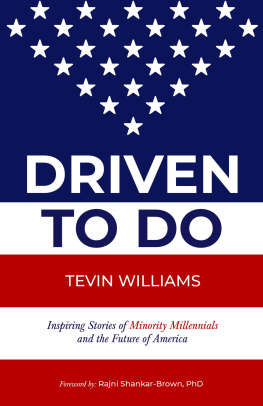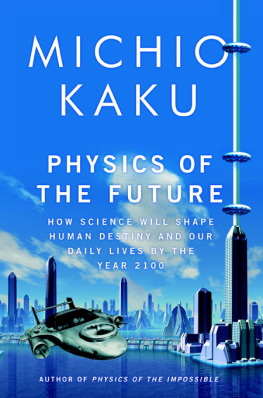If you can look into the seeds of time,
And say which grain will grow and which will not,
Speak then to me
B ANQUO TO THE THREE WITCHES , S HAKESPEARE , M ACBETH , ACT 1, SCENE 3
Open a creaky door in a haunted house and your spine will tingle. Anything could appear. We open doors into the future every moment of our lives. What lies behind them? How can we prepare for the unknown when, as St. Paul writes, we see through a glass, darkly? This book is about the hidden face of time, the parts that seem to lie in darkness because we havent been there yet. Its about how we try to imagine and prepare for and deal with whatever lurks in the strange place we describe as the future.
Trying to make sense of the future can feel like clutching at air. And yet, as airy as it seems, the future shapes an enormous amount of our thinking and feeling and doing. So much anxiety and effort, so much hope, and so much creativity are directed at the future. Indeed, it may be that most of our thinking is actually about possible futures. Most of the time we react to likely futures on autopilot. This is everyday future thinking. It is familiar and banal, and it is carried out by biological and neurological processes and algorithms that feel intuitive because they mostly work below consciousness. This is the future thinking we deploy when crossing a road and calculating if an oncoming semitrailer is going to hit us. We really face the mystery of the future when we set out in new directions, when a baby is born, when we face a sudden crisis, when we move to a new country or try to imagine the future of planet Earth. This is conscious future thinking. And once we start thinking consciously and carefully about it, we soon realize how weird the future is.
This book describes how philosophers and scientists and theologians have thought about the future. It discusses how other creatures, from bacteria to bats and baobab trees, deal with the same deep mystery using immensely sophisticated biochemical and neurological machinery. It explores the unique way in which our own species thinks collectively and often consciously about the future and tries to shape it. Finally, it describes some of the futures we can imagine today, for the next few decades, and in billions of years time. We will end with speculations about the end of time.
An Everyday Mystery
We face the strange existential mystery of the future in every moment of our lives. There seem to be many possible futures. Then, in a flash, all but one disappear, and we are left with a single present. We must deal with the present quickly because soon it will be flash frozen into memory and history, where it will change only as much as a fossilized mammoth can twist and pivot inside an ice-age glacier. On the other side of every creaky door we know there is an endless, impatient crowd of other possible futures lined up and waiting, some banal, some trivial, some mysterious, and some transformative. And we dont know which we will meet.
The mysteries that surround the future are enchanting as well as terrifying; they give life much of its richness, beauty, exhilaration, and meaningits zing! Do we really want to know what lies behind every door? Two thousand years ago, Cicero asked, Had [Julius Caesar] foreseen that in the Senate, chosen in most part by himself he would be put to death by most noble citizens, some of whom owed all that they had to him, and that he would fall to so low an estate that no friendno, not even a slavewould approach his dead body, in what agony of soul would he have spent his life! Cicero knew Caesar and may have seen him knifed in the Senate on the ides (the fifteenth) of March 44 BCE . When Caesar died, Cicero was writing his great work on divination. So the example was vivid and strongly felt. Our ignorance of the future gives life much of its drama and excitement. And it gives us the freedom to chooseand the moral duty to choose thoughtfully.
A lot of the time, though, we really do want to glimpse what lies ahead. What clues do we have? When we journey to another country, we can talk to people who have been there, or we can travel with Lonely Planet guidebooks, as nineteenth-century Europeans traveled with their Baedekers. As a professional historian, I have traveled to the past in my imagination, using Baedekers built from the records and memoirs of those who lived in the past. I was not traveling blind. When we enter the future, though, we have no guides because no one has been there.
Not a soul. As the philosopher of history R. G. Collingwood reminded us, the future leaves no documents.looking for patterns and trends and signs and imagining possible futures, good and bad; we try to interpret messages in dreams, or in the stars, or in the warnings or promises of soothsayers or financial advisers. We ask parents or doctors or teachers. Modern governments ask economists and statisticians and scientists (and sometimes pay them a lot of money). And we engage in all this activity because, though the future leaves no documents, we do have some clues about what may be coming. And sometimes we can make forecasts with what Leibniz called moral [i.e., near] certainty. The sun will rise tomorrow; I will die someday; the government will insist I pay taxes. I cannot say these things with absolute certainty. But I can get close enough. What I cannot do is predict the future in detail, except in rare cases, such as solar eclipses. Unlike the past, which sparkles with details, the future is a foggy world of vague shapes moving in the gloaming.
















